School of VBE: Communicating With Customers Student Workbook RMIT
VerifiedAdded on 2022/12/29
|49
|7045
|27
Homework Assignment
AI Summary
This student workbook from RMIT University's School of Vocational Business Education (VBE) covers key marketing concepts related to communicating with customers. It begins with an introduction to marketing definitions, the marketing mix, and core marketing concepts. The workbook delves into market research, analyzing consumer and business markets, and identifying market segments. It explores promotional strategies including advertising, public relations, personal selling, and direct marketing. Furthermore, the workbook covers distribution strategies, marketing channels, and supply chain management. The content includes activities, definitions, and examples to aid understanding of the material. The workbook aims to equip students with the skills to create marketing plans and understand the dynamic nature of the marketplace.
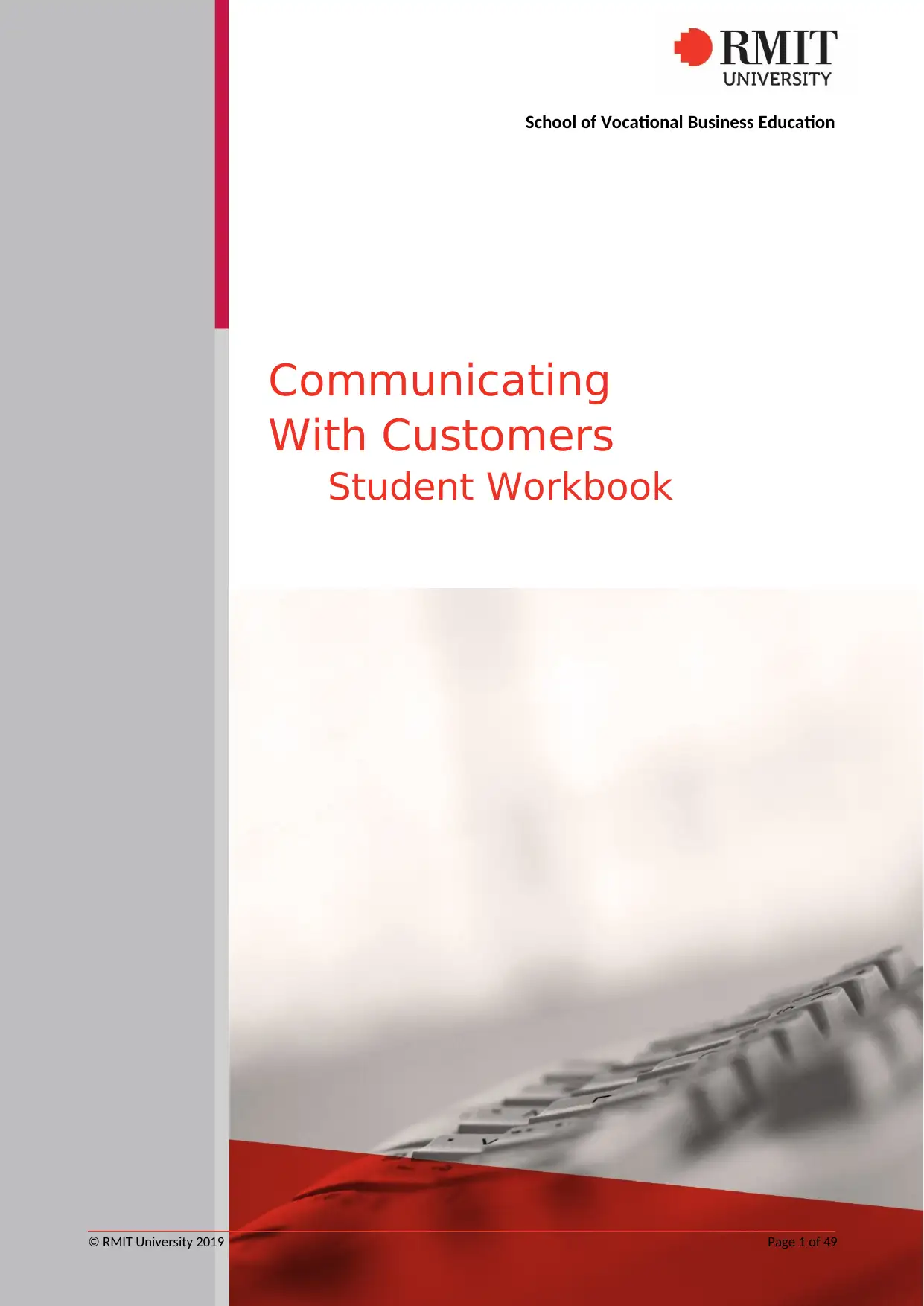
School of Vocational Business Education
© RMIT University 2019 Page 1 of 49
Communicating
With Customers
Student Workbook
© RMIT University 2019 Page 1 of 49
Communicating
With Customers
Student Workbook
Paraphrase This Document
Need a fresh take? Get an instant paraphrase of this document with our AI Paraphraser
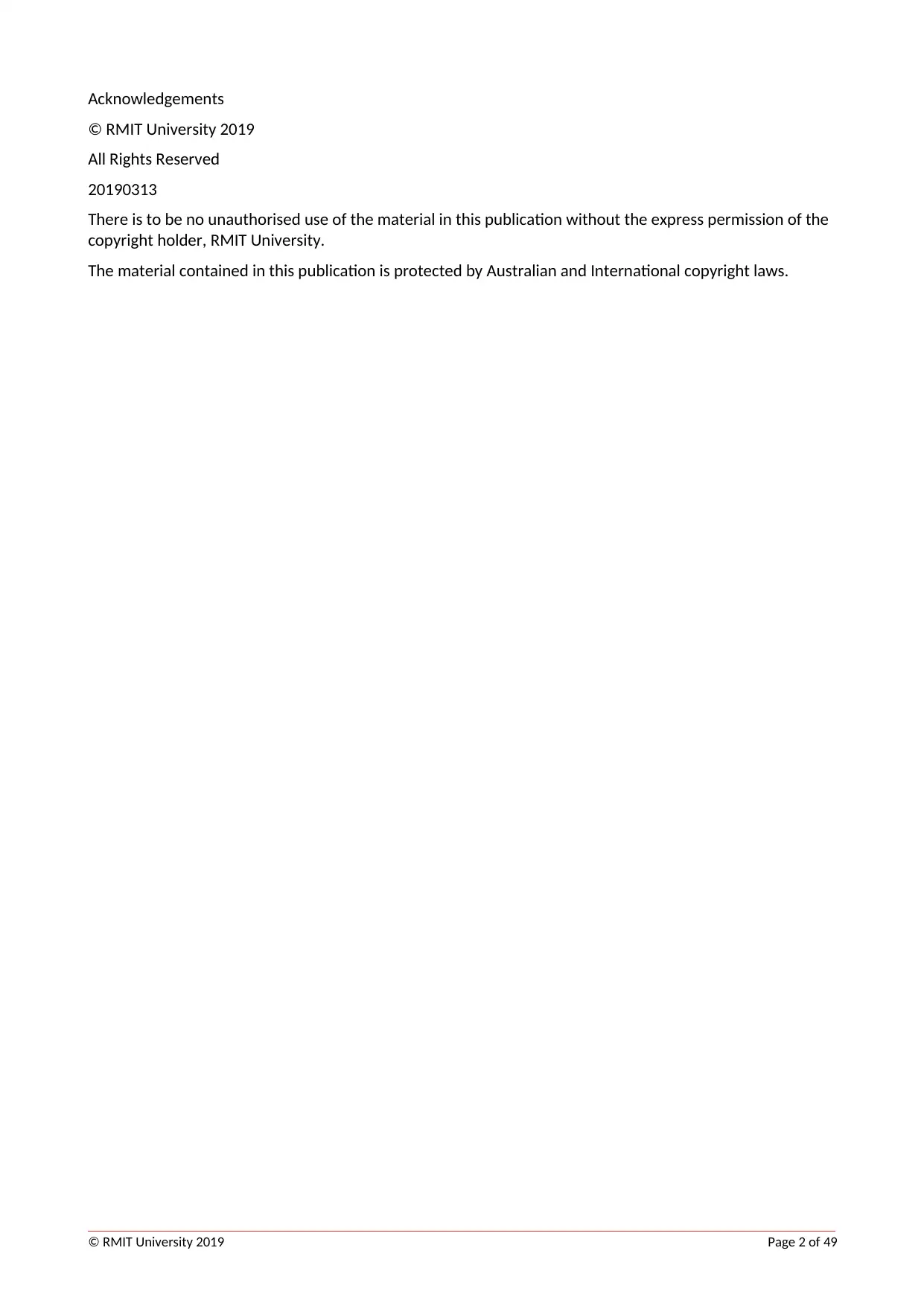
Acknowledgements
© RMIT University 2019
All Rights Reserved
20190313
There is to be no unauthorised use of the material in this publication without the express permission of the
copyright holder, RMIT University.
The material contained in this publication is protected by Australian and International copyright laws.
© RMIT University 2019 Page 2 of 49
© RMIT University 2019
All Rights Reserved
20190313
There is to be no unauthorised use of the material in this publication without the express permission of the
copyright holder, RMIT University.
The material contained in this publication is protected by Australian and International copyright laws.
© RMIT University 2019 Page 2 of 49
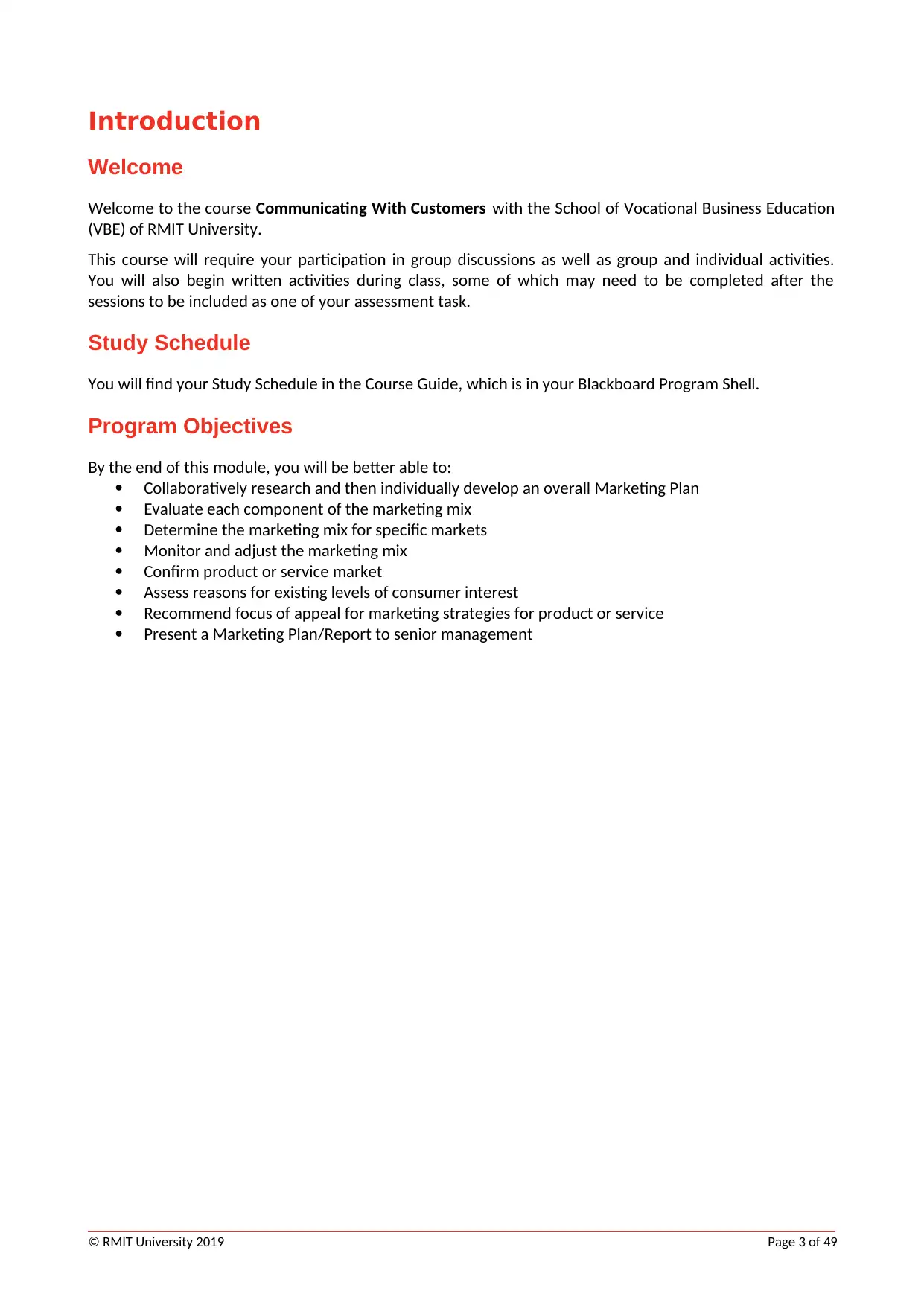
Introduction
Welcome
Welcome to the course Communicating With Customers with the School of Vocational Business Education
(VBE) of RMIT University.
This course will require your participation in group discussions as well as group and individual activities.
You will also begin written activities during class, some of which may need to be completed after the
sessions to be included as one of your assessment task.
Study Schedule
You will find your Study Schedule in the Course Guide, which is in your Blackboard Program Shell.
Program Objectives
By the end of this module, you will be better able to:
Collaboratively research and then individually develop an overall Marketing Plan
Evaluate each component of the marketing mix
Determine the marketing mix for specific markets
Monitor and adjust the marketing mix
Confirm product or service market
Assess reasons for existing levels of consumer interest
Recommend focus of appeal for marketing strategies for product or service
Present a Marketing Plan/Report to senior management
© RMIT University 2019 Page 3 of 49
Welcome
Welcome to the course Communicating With Customers with the School of Vocational Business Education
(VBE) of RMIT University.
This course will require your participation in group discussions as well as group and individual activities.
You will also begin written activities during class, some of which may need to be completed after the
sessions to be included as one of your assessment task.
Study Schedule
You will find your Study Schedule in the Course Guide, which is in your Blackboard Program Shell.
Program Objectives
By the end of this module, you will be better able to:
Collaboratively research and then individually develop an overall Marketing Plan
Evaluate each component of the marketing mix
Determine the marketing mix for specific markets
Monitor and adjust the marketing mix
Confirm product or service market
Assess reasons for existing levels of consumer interest
Recommend focus of appeal for marketing strategies for product or service
Present a Marketing Plan/Report to senior management
© RMIT University 2019 Page 3 of 49
⊘ This is a preview!⊘
Do you want full access?
Subscribe today to unlock all pages.

Trusted by 1+ million students worldwide
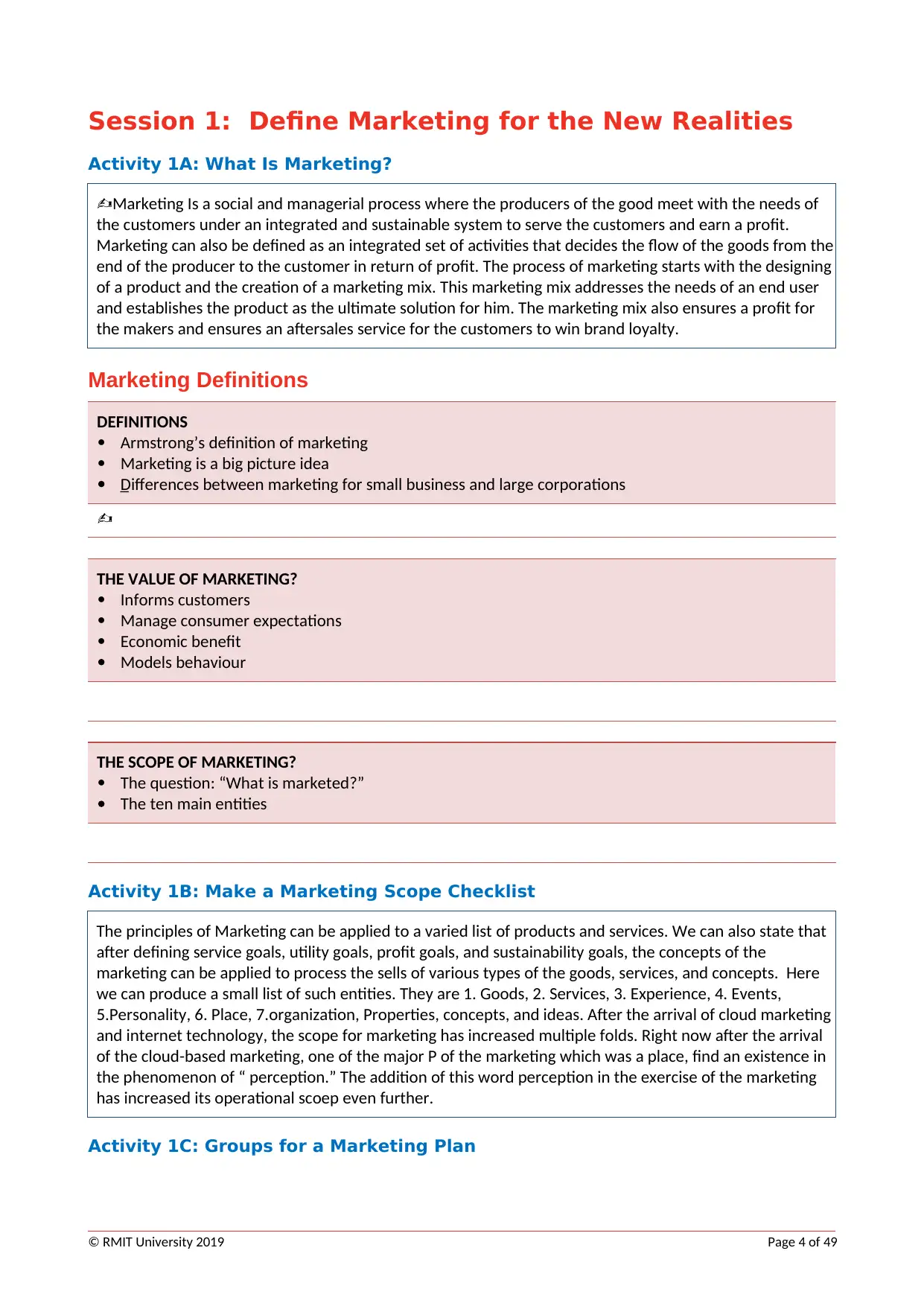
Session 1: Define Marketing for the New Realities
Activity 1A: What Is Marketing?
Marketing Is a social and managerial process where the producers of the good meet with the needs of
the customers under an integrated and sustainable system to serve the customers and earn a profit.
Marketing can also be defined as an integrated set of activities that decides the flow of the goods from the
end of the producer to the customer in return of profit. The process of marketing starts with the designing
of a product and the creation of a marketing mix. This marketing mix addresses the needs of an end user
and establishes the product as the ultimate solution for him. The marketing mix also ensures a profit for
the makers and ensures an aftersales service for the customers to win brand loyalty.
Marketing Definitions
DEFINITIONS
Armstrong’s definition of marketing
Marketing is a big picture idea
_Differences between marketing for small business and large corporations
THE VALUE OF MARKETING?
Informs customers
Manage consumer expectations
Economic benefit
Models behaviour
THE SCOPE OF MARKETING?
The question: “What is marketed?”
The ten main entities
Activity 1B: Make a Marketing Scope Checklist
The principles of Marketing can be applied to a varied list of products and services. We can also state that
after defining service goals, utility goals, profit goals, and sustainability goals, the concepts of the
marketing can be applied to process the sells of various types of the goods, services, and concepts. Here
we can produce a small list of such entities. They are 1. Goods, 2. Services, 3. Experience, 4. Events,
5.Personality, 6. Place, 7.organization, Properties, concepts, and ideas. After the arrival of cloud marketing
and internet technology, the scope for marketing has increased multiple folds. Right now after the arrival
of the cloud-based marketing, one of the major P of the marketing which was a place, find an existence in
the phenomenon of “ perception.” The addition of this word perception in the exercise of the marketing
has increased its operational scoep even further.
Activity 1C: Groups for a Marketing Plan
© RMIT University 2019 Page 4 of 49
Activity 1A: What Is Marketing?
Marketing Is a social and managerial process where the producers of the good meet with the needs of
the customers under an integrated and sustainable system to serve the customers and earn a profit.
Marketing can also be defined as an integrated set of activities that decides the flow of the goods from the
end of the producer to the customer in return of profit. The process of marketing starts with the designing
of a product and the creation of a marketing mix. This marketing mix addresses the needs of an end user
and establishes the product as the ultimate solution for him. The marketing mix also ensures a profit for
the makers and ensures an aftersales service for the customers to win brand loyalty.
Marketing Definitions
DEFINITIONS
Armstrong’s definition of marketing
Marketing is a big picture idea
_Differences between marketing for small business and large corporations
THE VALUE OF MARKETING?
Informs customers
Manage consumer expectations
Economic benefit
Models behaviour
THE SCOPE OF MARKETING?
The question: “What is marketed?”
The ten main entities
Activity 1B: Make a Marketing Scope Checklist
The principles of Marketing can be applied to a varied list of products and services. We can also state that
after defining service goals, utility goals, profit goals, and sustainability goals, the concepts of the
marketing can be applied to process the sells of various types of the goods, services, and concepts. Here
we can produce a small list of such entities. They are 1. Goods, 2. Services, 3. Experience, 4. Events,
5.Personality, 6. Place, 7.organization, Properties, concepts, and ideas. After the arrival of cloud marketing
and internet technology, the scope for marketing has increased multiple folds. Right now after the arrival
of the cloud-based marketing, one of the major P of the marketing which was a place, find an existence in
the phenomenon of “ perception.” The addition of this word perception in the exercise of the marketing
has increased its operational scoep even further.
Activity 1C: Groups for a Marketing Plan
© RMIT University 2019 Page 4 of 49
Paraphrase This Document
Need a fresh take? Get an instant paraphrase of this document with our AI Paraphraser
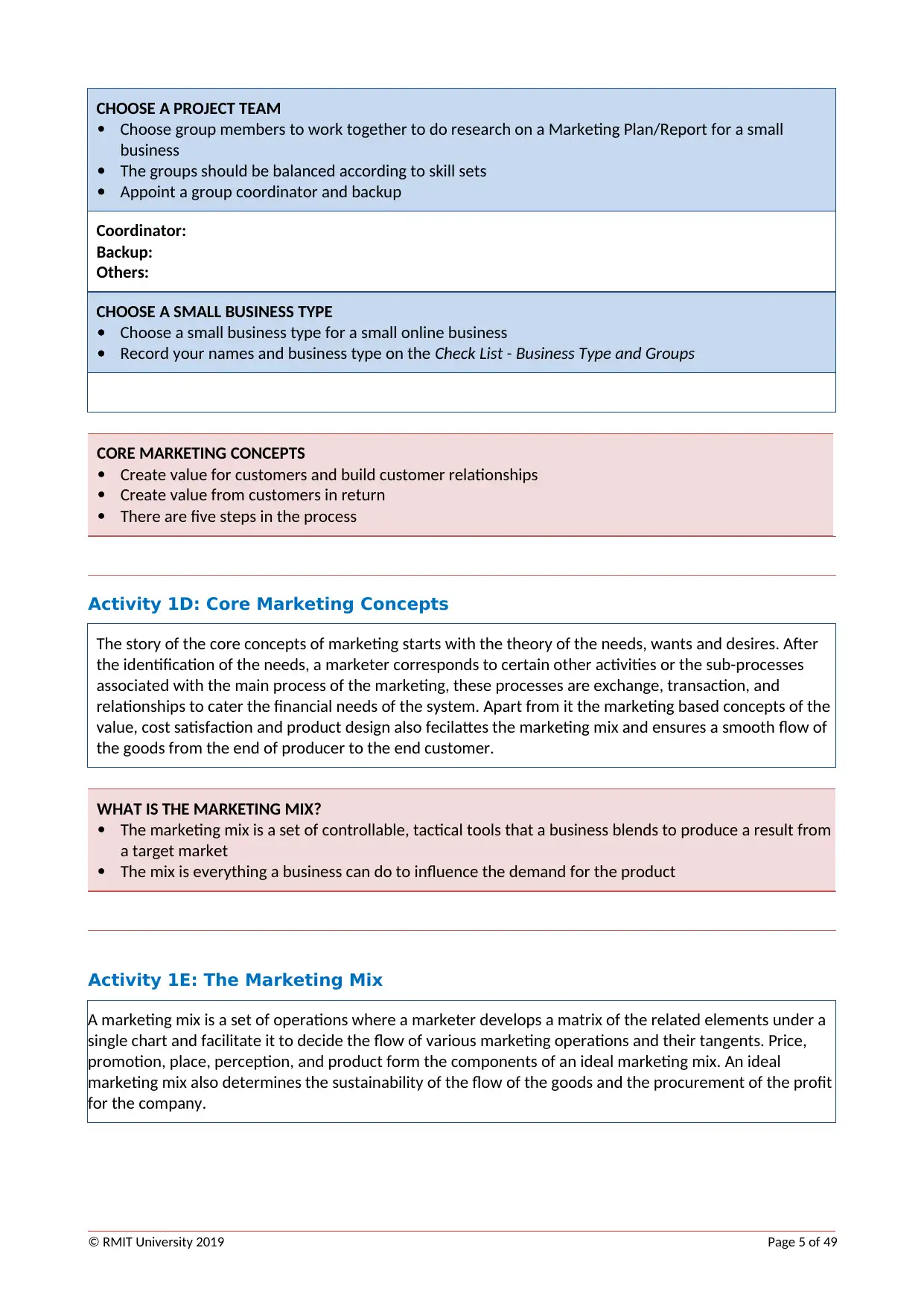
CHOOSE A PROJECT TEAM
Choose group members to work together to do research on a Marketing Plan/Report for a small
business
The groups should be balanced according to skill sets
Appoint a group coordinator and backup
Coordinator:
Backup:
Others:
CHOOSE A SMALL BUSINESS TYPE
Choose a small business type for a small online business
Record your names and business type on the Check List - Business Type and Groups
CORE MARKETING CONCEPTS
Create value for customers and build customer relationships
Create value from customers in return
There are five steps in the process
Activity 1D: Core Marketing Concepts
The story of the core concepts of marketing starts with the theory of the needs, wants and desires. After
the identification of the needs, a marketer corresponds to certain other activities or the sub-processes
associated with the main process of the marketing, these processes are exchange, transaction, and
relationships to cater the financial needs of the system. Apart from it the marketing based concepts of the
value, cost satisfaction and product design also fecilattes the marketing mix and ensures a smooth flow of
the goods from the end of producer to the end customer.
WHAT IS THE MARKETING MIX?
The marketing mix is a set of controllable, tactical tools that a business blends to produce a result from
a target market
The mix is everything a business can do to influence the demand for the product
Activity 1E: The Marketing Mix
A marketing mix is a set of operations where a marketer develops a matrix of the related elements under a
single chart and facilitate it to decide the flow of various marketing operations and their tangents. Price,
promotion, place, perception, and product form the components of an ideal marketing mix. An ideal
marketing mix also determines the sustainability of the flow of the goods and the procurement of the profit
for the company.
© RMIT University 2019 Page 5 of 49
Choose group members to work together to do research on a Marketing Plan/Report for a small
business
The groups should be balanced according to skill sets
Appoint a group coordinator and backup
Coordinator:
Backup:
Others:
CHOOSE A SMALL BUSINESS TYPE
Choose a small business type for a small online business
Record your names and business type on the Check List - Business Type and Groups
CORE MARKETING CONCEPTS
Create value for customers and build customer relationships
Create value from customers in return
There are five steps in the process
Activity 1D: Core Marketing Concepts
The story of the core concepts of marketing starts with the theory of the needs, wants and desires. After
the identification of the needs, a marketer corresponds to certain other activities or the sub-processes
associated with the main process of the marketing, these processes are exchange, transaction, and
relationships to cater the financial needs of the system. Apart from it the marketing based concepts of the
value, cost satisfaction and product design also fecilattes the marketing mix and ensures a smooth flow of
the goods from the end of producer to the end customer.
WHAT IS THE MARKETING MIX?
The marketing mix is a set of controllable, tactical tools that a business blends to produce a result from
a target market
The mix is everything a business can do to influence the demand for the product
Activity 1E: The Marketing Mix
A marketing mix is a set of operations where a marketer develops a matrix of the related elements under a
single chart and facilitate it to decide the flow of various marketing operations and their tangents. Price,
promotion, place, perception, and product form the components of an ideal marketing mix. An ideal
marketing mix also determines the sustainability of the flow of the goods and the procurement of the profit
for the company.
© RMIT University 2019 Page 5 of 49
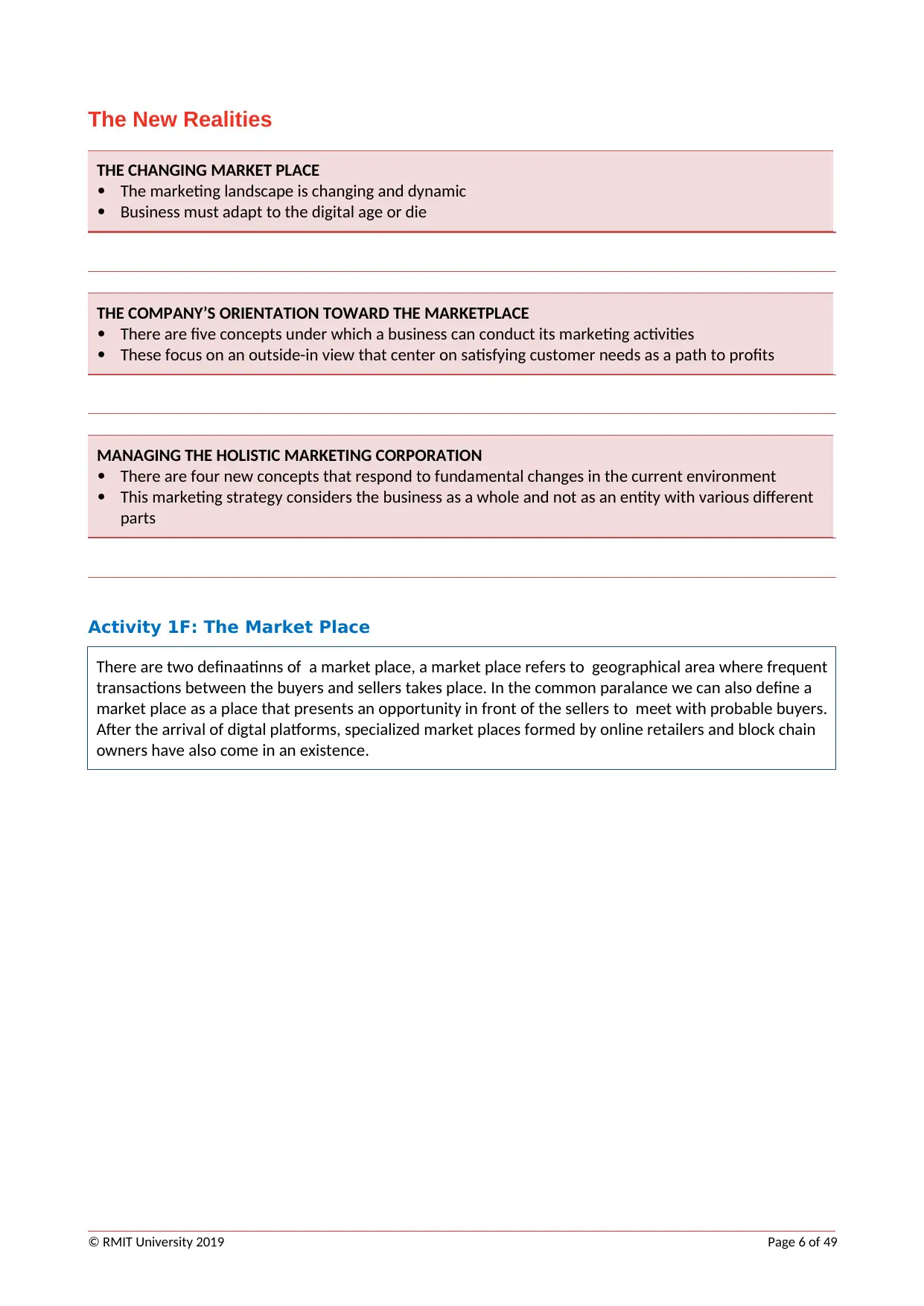
The New Realities
THE CHANGING MARKET PLACE
The marketing landscape is changing and dynamic
Business must adapt to the digital age or die
THE COMPANY’S ORIENTATION TOWARD THE MARKETPLACE
There are five concepts under which a business can conduct its marketing activities
These focus on an outside-in view that center on satisfying customer needs as a path to profits
MANAGING THE HOLISTIC MARKETING CORPORATION
There are four new concepts that respond to fundamental changes in the current environment
This marketing strategy considers the business as a whole and not as an entity with various different
parts
Activity 1F: The Market Place
There are two definaatinns of a market place, a market place refers to geographical area where frequent
transactions between the buyers and sellers takes place. In the common paralance we can also define a
market place as a place that presents an opportunity in front of the sellers to meet with probable buyers.
After the arrival of digtal platforms, specialized market places formed by online retailers and block chain
owners have also come in an existence.
© RMIT University 2019 Page 6 of 49
THE CHANGING MARKET PLACE
The marketing landscape is changing and dynamic
Business must adapt to the digital age or die
THE COMPANY’S ORIENTATION TOWARD THE MARKETPLACE
There are five concepts under which a business can conduct its marketing activities
These focus on an outside-in view that center on satisfying customer needs as a path to profits
MANAGING THE HOLISTIC MARKETING CORPORATION
There are four new concepts that respond to fundamental changes in the current environment
This marketing strategy considers the business as a whole and not as an entity with various different
parts
Activity 1F: The Market Place
There are two definaatinns of a market place, a market place refers to geographical area where frequent
transactions between the buyers and sellers takes place. In the common paralance we can also define a
market place as a place that presents an opportunity in front of the sellers to meet with probable buyers.
After the arrival of digtal platforms, specialized market places formed by online retailers and block chain
owners have also come in an existence.
© RMIT University 2019 Page 6 of 49
⊘ This is a preview!⊘
Do you want full access?
Subscribe today to unlock all pages.

Trusted by 1+ million students worldwide
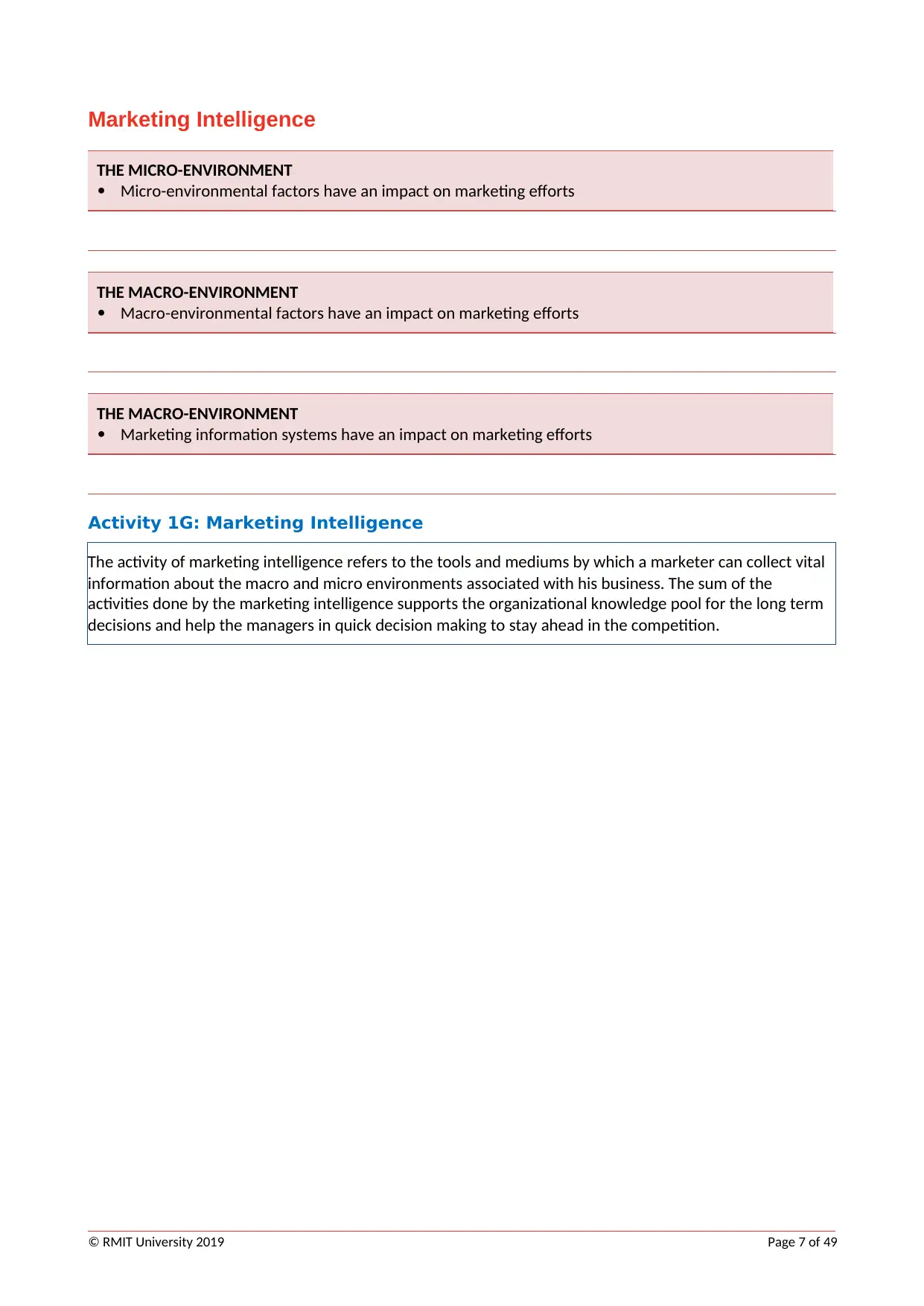
Marketing Intelligence
THE MICRO-ENVIRONMENT
Micro-environmental factors have an impact on marketing efforts
THE MACRO-ENVIRONMENT
Macro-environmental factors have an impact on marketing efforts
THE MACRO-ENVIRONMENT
Marketing information systems have an impact on marketing efforts
Activity 1G: Marketing Intelligence
The activity of marketing intelligence refers to the tools and mediums by which a marketer can collect vital
information about the macro and micro environments associated with his business. The sum of the
activities done by the marketing intelligence supports the organizational knowledge pool for the long term
decisions and help the managers in quick decision making to stay ahead in the competition.
© RMIT University 2019 Page 7 of 49
THE MICRO-ENVIRONMENT
Micro-environmental factors have an impact on marketing efforts
THE MACRO-ENVIRONMENT
Macro-environmental factors have an impact on marketing efforts
THE MACRO-ENVIRONMENT
Marketing information systems have an impact on marketing efforts
Activity 1G: Marketing Intelligence
The activity of marketing intelligence refers to the tools and mediums by which a marketer can collect vital
information about the macro and micro environments associated with his business. The sum of the
activities done by the marketing intelligence supports the organizational knowledge pool for the long term
decisions and help the managers in quick decision making to stay ahead in the competition.
© RMIT University 2019 Page 7 of 49
Paraphrase This Document
Need a fresh take? Get an instant paraphrase of this document with our AI Paraphraser
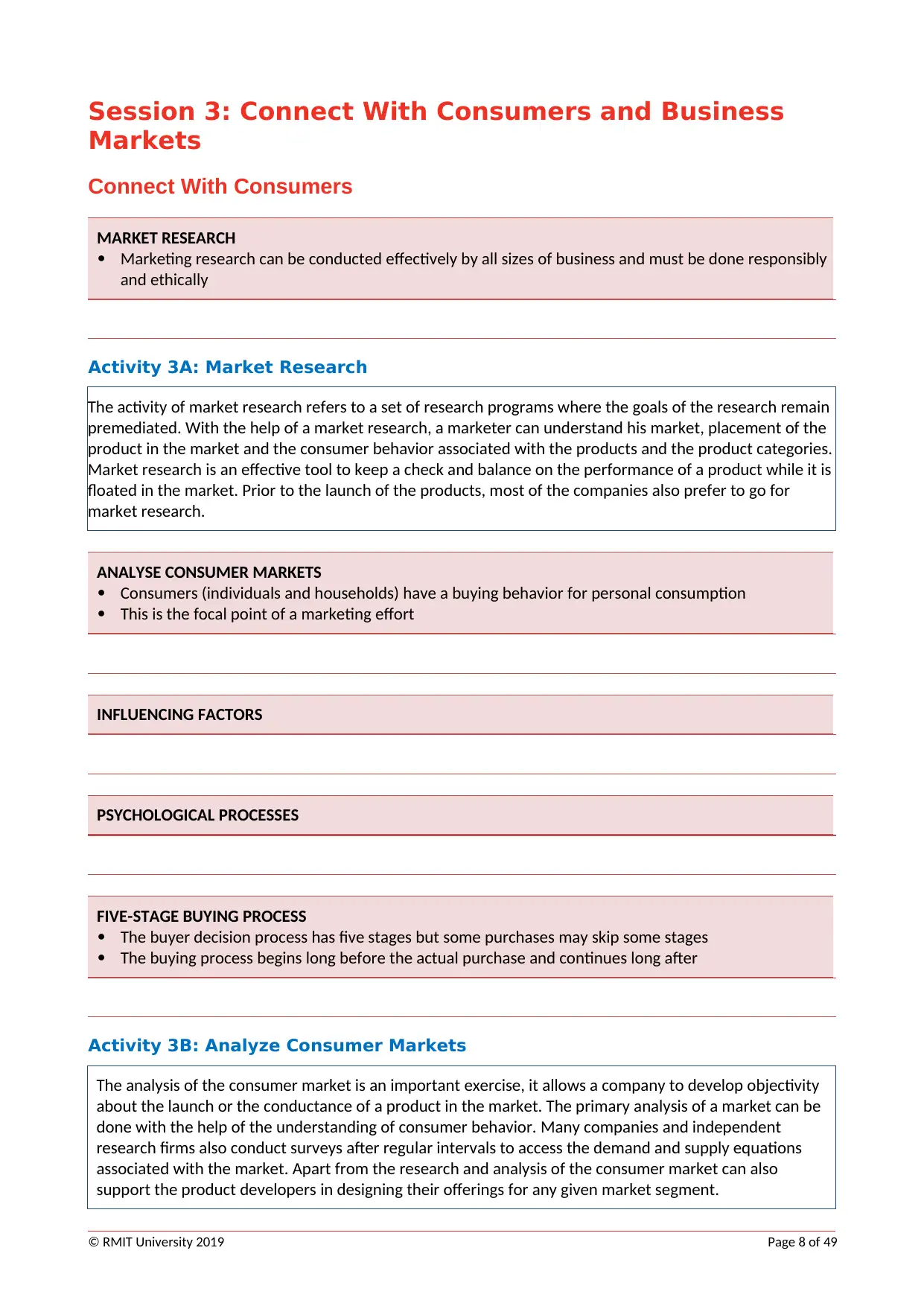
Session 3: Connect With Consumers and Business
Markets
Connect With Consumers
MARKET RESEARCH
Marketing research can be conducted effectively by all sizes of business and must be done responsibly
and ethically
Activity 3A: Market Research
The activity of market research refers to a set of research programs where the goals of the research remain
premediated. With the help of a market research, a marketer can understand his market, placement of the
product in the market and the consumer behavior associated with the products and the product categories.
Market research is an effective tool to keep a check and balance on the performance of a product while it is
floated in the market. Prior to the launch of the products, most of the companies also prefer to go for
market research.
ANALYSE CONSUMER MARKETS
Consumers (individuals and households) have a buying behavior for personal consumption
This is the focal point of a marketing effort
INFLUENCING FACTORS
PSYCHOLOGICAL PROCESSES
FIVE-STAGE BUYING PROCESS
The buyer decision process has five stages but some purchases may skip some stages
The buying process begins long before the actual purchase and continues long after
Activity 3B: Analyze Consumer Markets
The analysis of the consumer market is an important exercise, it allows a company to develop objectivity
about the launch or the conductance of a product in the market. The primary analysis of a market can be
done with the help of the understanding of consumer behavior. Many companies and independent
research firms also conduct surveys after regular intervals to access the demand and supply equations
associated with the market. Apart from the research and analysis of the consumer market can also
support the product developers in designing their offerings for any given market segment.
© RMIT University 2019 Page 8 of 49
Markets
Connect With Consumers
MARKET RESEARCH
Marketing research can be conducted effectively by all sizes of business and must be done responsibly
and ethically
Activity 3A: Market Research
The activity of market research refers to a set of research programs where the goals of the research remain
premediated. With the help of a market research, a marketer can understand his market, placement of the
product in the market and the consumer behavior associated with the products and the product categories.
Market research is an effective tool to keep a check and balance on the performance of a product while it is
floated in the market. Prior to the launch of the products, most of the companies also prefer to go for
market research.
ANALYSE CONSUMER MARKETS
Consumers (individuals and households) have a buying behavior for personal consumption
This is the focal point of a marketing effort
INFLUENCING FACTORS
PSYCHOLOGICAL PROCESSES
FIVE-STAGE BUYING PROCESS
The buyer decision process has five stages but some purchases may skip some stages
The buying process begins long before the actual purchase and continues long after
Activity 3B: Analyze Consumer Markets
The analysis of the consumer market is an important exercise, it allows a company to develop objectivity
about the launch or the conductance of a product in the market. The primary analysis of a market can be
done with the help of the understanding of consumer behavior. Many companies and independent
research firms also conduct surveys after regular intervals to access the demand and supply equations
associated with the market. Apart from the research and analysis of the consumer market can also
support the product developers in designing their offerings for any given market segment.
© RMIT University 2019 Page 8 of 49

© RMIT University 2019 Page 9 of 49
⊘ This is a preview!⊘
Do you want full access?
Subscribe today to unlock all pages.

Trusted by 1+ million students worldwide
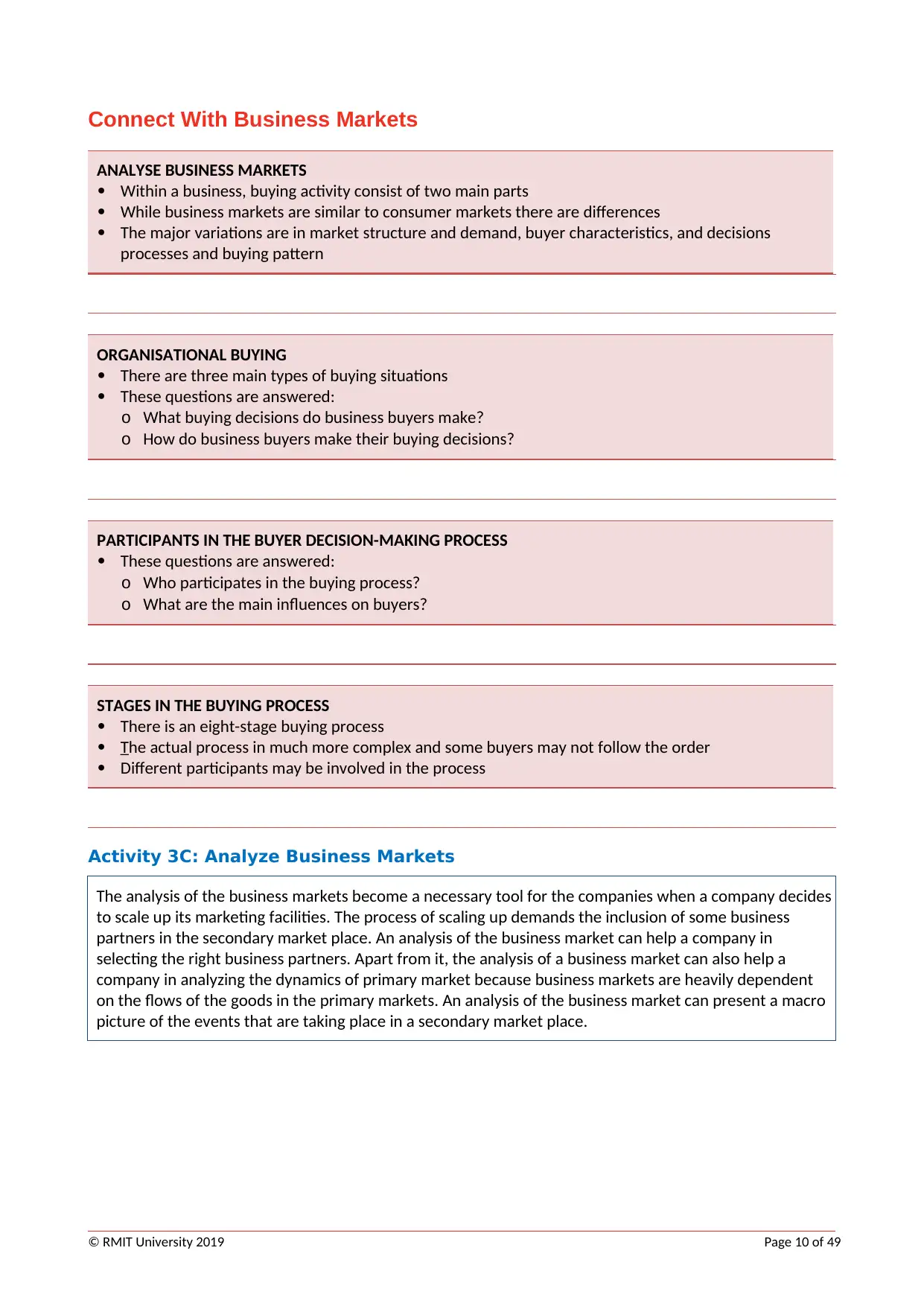
Connect With Business Markets
ANALYSE BUSINESS MARKETS
Within a business, buying activity consist of two main parts
While business markets are similar to consumer markets there are differences
The major variations are in market structure and demand, buyer characteristics, and decisions
processes and buying pattern
ORGANISATIONAL BUYING
There are three main types of buying situations
These questions are answered:
o What buying decisions do business buyers make?
o How do business buyers make their buying decisions?
PARTICIPANTS IN THE BUYER DECISION-MAKING PROCESS
These questions are answered:
o Who participates in the buying process?
o What are the main influences on buyers?
STAGES IN THE BUYING PROCESS
There is an eight-stage buying process
_The actual process in much more complex and some buyers may not follow the order
Different participants may be involved in the process
Activity 3C: Analyze Business Markets
The analysis of the business markets become a necessary tool for the companies when a company decides
to scale up its marketing facilities. The process of scaling up demands the inclusion of some business
partners in the secondary market place. An analysis of the business market can help a company in
selecting the right business partners. Apart from it, the analysis of a business market can also help a
company in analyzing the dynamics of primary market because business markets are heavily dependent
on the flows of the goods in the primary markets. An analysis of the business market can present a macro
picture of the events that are taking place in a secondary market place.
© RMIT University 2019 Page 10 of 49
ANALYSE BUSINESS MARKETS
Within a business, buying activity consist of two main parts
While business markets are similar to consumer markets there are differences
The major variations are in market structure and demand, buyer characteristics, and decisions
processes and buying pattern
ORGANISATIONAL BUYING
There are three main types of buying situations
These questions are answered:
o What buying decisions do business buyers make?
o How do business buyers make their buying decisions?
PARTICIPANTS IN THE BUYER DECISION-MAKING PROCESS
These questions are answered:
o Who participates in the buying process?
o What are the main influences on buyers?
STAGES IN THE BUYING PROCESS
There is an eight-stage buying process
_The actual process in much more complex and some buyers may not follow the order
Different participants may be involved in the process
Activity 3C: Analyze Business Markets
The analysis of the business markets become a necessary tool for the companies when a company decides
to scale up its marketing facilities. The process of scaling up demands the inclusion of some business
partners in the secondary market place. An analysis of the business market can help a company in
selecting the right business partners. Apart from it, the analysis of a business market can also help a
company in analyzing the dynamics of primary market because business markets are heavily dependent
on the flows of the goods in the primary markets. An analysis of the business market can present a macro
picture of the events that are taking place in a secondary market place.
© RMIT University 2019 Page 10 of 49
Paraphrase This Document
Need a fresh take? Get an instant paraphrase of this document with our AI Paraphraser
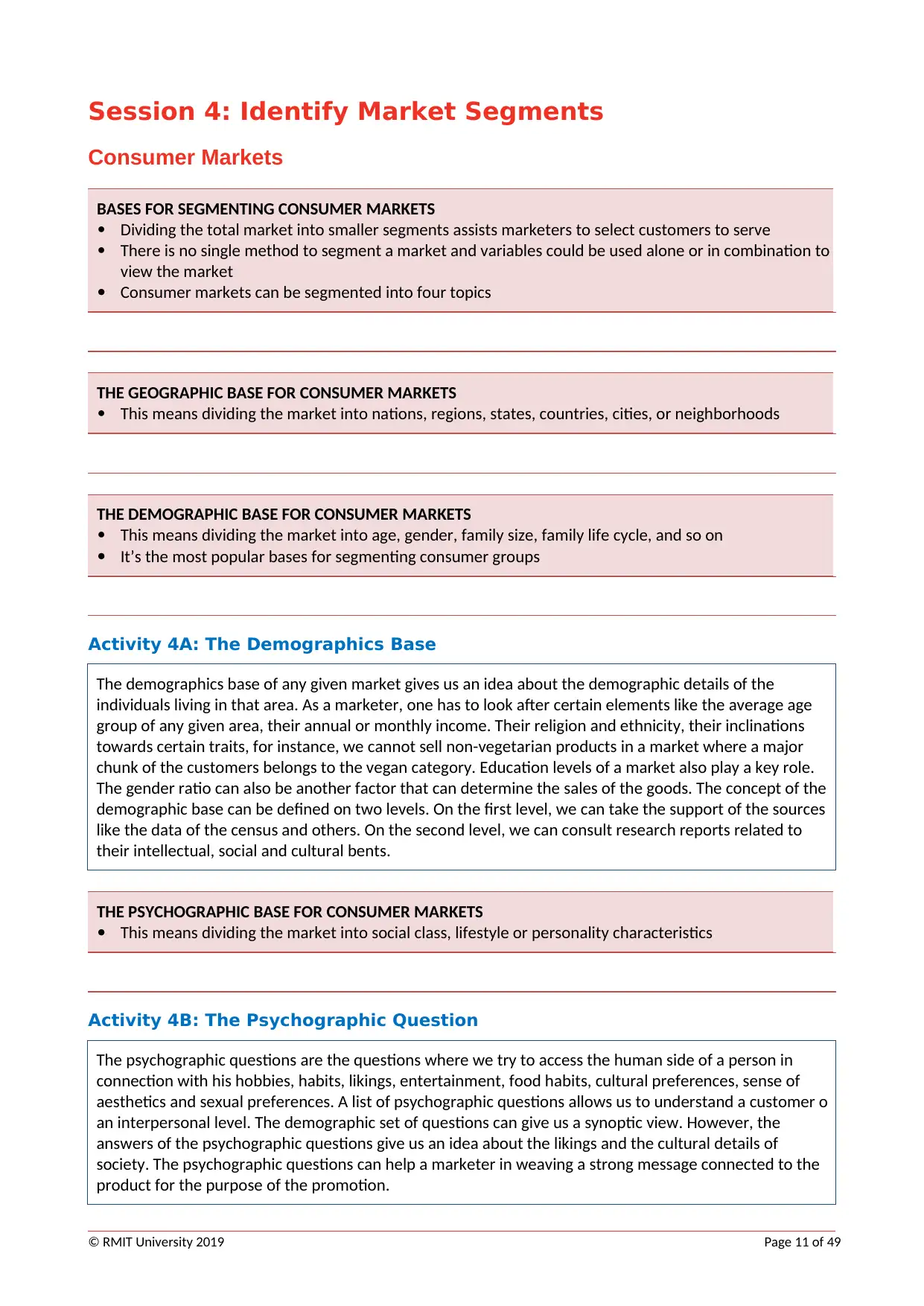
Session 4: Identify Market Segments
Consumer Markets
BASES FOR SEGMENTING CONSUMER MARKETS
Dividing the total market into smaller segments assists marketers to select customers to serve
There is no single method to segment a market and variables could be used alone or in combination to
view the market
Consumer markets can be segmented into four topics
THE GEOGRAPHIC BASE FOR CONSUMER MARKETS
This means dividing the market into nations, regions, states, countries, cities, or neighborhoods
THE DEMOGRAPHIC BASE FOR CONSUMER MARKETS
This means dividing the market into age, gender, family size, family life cycle, and so on
It’s the most popular bases for segmenting consumer groups
Activity 4A: The Demographics Base
The demographics base of any given market gives us an idea about the demographic details of the
individuals living in that area. As a marketer, one has to look after certain elements like the average age
group of any given area, their annual or monthly income. Their religion and ethnicity, their inclinations
towards certain traits, for instance, we cannot sell non-vegetarian products in a market where a major
chunk of the customers belongs to the vegan category. Education levels of a market also play a key role.
The gender ratio can also be another factor that can determine the sales of the goods. The concept of the
demographic base can be defined on two levels. On the first level, we can take the support of the sources
like the data of the census and others. On the second level, we can consult research reports related to
their intellectual, social and cultural bents.
THE PSYCHOGRAPHIC BASE FOR CONSUMER MARKETS
This means dividing the market into social class, lifestyle or personality characteristics
Activity 4B: The Psychographic Question
The psychographic questions are the questions where we try to access the human side of a person in
connection with his hobbies, habits, likings, entertainment, food habits, cultural preferences, sense of
aesthetics and sexual preferences. A list of psychographic questions allows us to understand a customer o
an interpersonal level. The demographic set of questions can give us a synoptic view. However, the
answers of the psychographic questions give us an idea about the likings and the cultural details of
society. The psychographic questions can help a marketer in weaving a strong message connected to the
product for the purpose of the promotion.
© RMIT University 2019 Page 11 of 49
Consumer Markets
BASES FOR SEGMENTING CONSUMER MARKETS
Dividing the total market into smaller segments assists marketers to select customers to serve
There is no single method to segment a market and variables could be used alone or in combination to
view the market
Consumer markets can be segmented into four topics
THE GEOGRAPHIC BASE FOR CONSUMER MARKETS
This means dividing the market into nations, regions, states, countries, cities, or neighborhoods
THE DEMOGRAPHIC BASE FOR CONSUMER MARKETS
This means dividing the market into age, gender, family size, family life cycle, and so on
It’s the most popular bases for segmenting consumer groups
Activity 4A: The Demographics Base
The demographics base of any given market gives us an idea about the demographic details of the
individuals living in that area. As a marketer, one has to look after certain elements like the average age
group of any given area, their annual or monthly income. Their religion and ethnicity, their inclinations
towards certain traits, for instance, we cannot sell non-vegetarian products in a market where a major
chunk of the customers belongs to the vegan category. Education levels of a market also play a key role.
The gender ratio can also be another factor that can determine the sales of the goods. The concept of the
demographic base can be defined on two levels. On the first level, we can take the support of the sources
like the data of the census and others. On the second level, we can consult research reports related to
their intellectual, social and cultural bents.
THE PSYCHOGRAPHIC BASE FOR CONSUMER MARKETS
This means dividing the market into social class, lifestyle or personality characteristics
Activity 4B: The Psychographic Question
The psychographic questions are the questions where we try to access the human side of a person in
connection with his hobbies, habits, likings, entertainment, food habits, cultural preferences, sense of
aesthetics and sexual preferences. A list of psychographic questions allows us to understand a customer o
an interpersonal level. The demographic set of questions can give us a synoptic view. However, the
answers of the psychographic questions give us an idea about the likings and the cultural details of
society. The psychographic questions can help a marketer in weaving a strong message connected to the
product for the purpose of the promotion.
© RMIT University 2019 Page 11 of 49
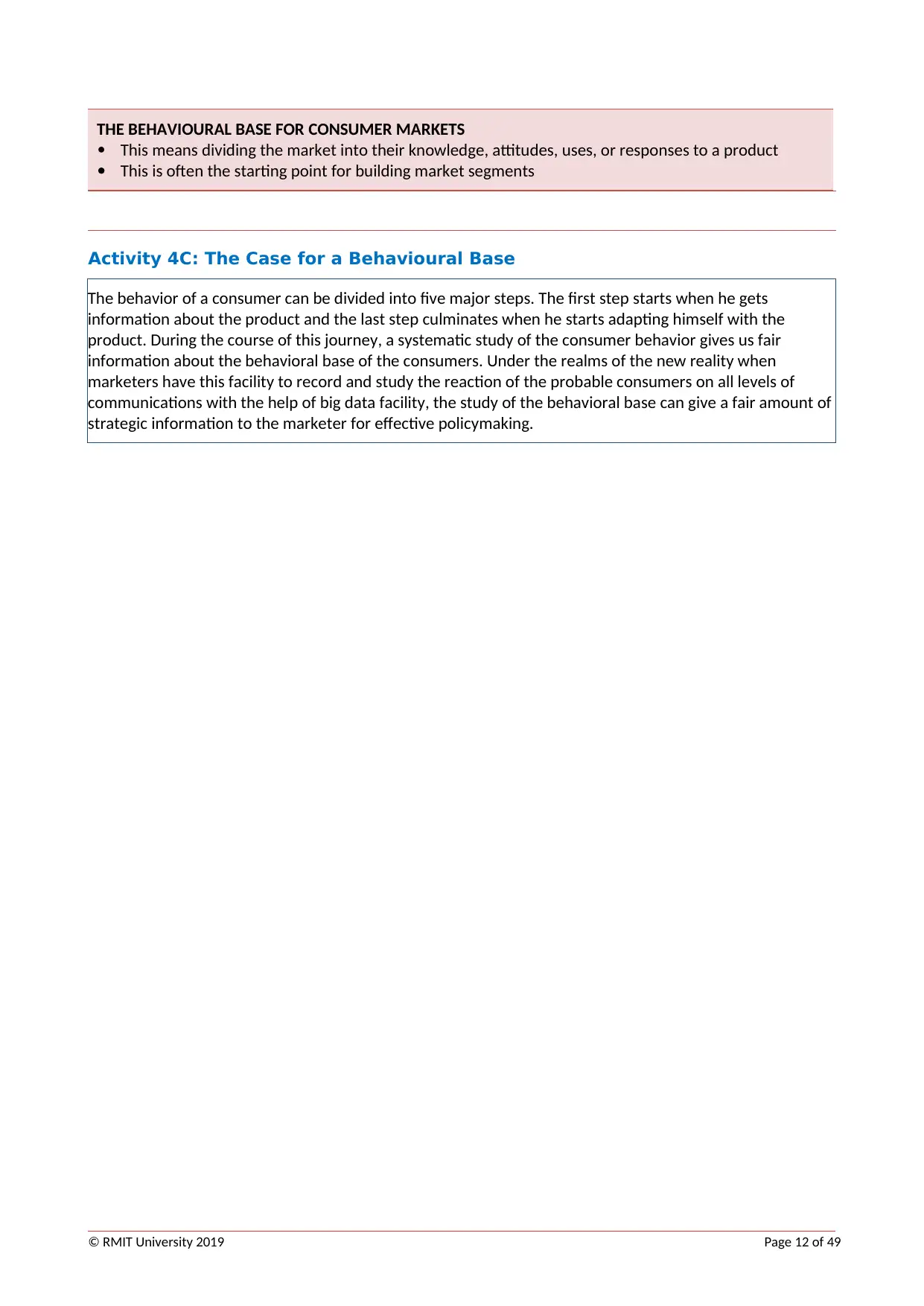
THE BEHAVIOURAL BASE FOR CONSUMER MARKETS
This means dividing the market into their knowledge, attitudes, uses, or responses to a product
This is often the starting point for building market segments
Activity 4C: The Case for a Behavioural Base
The behavior of a consumer can be divided into five major steps. The first step starts when he gets
information about the product and the last step culminates when he starts adapting himself with the
product. During the course of this journey, a systematic study of the consumer behavior gives us fair
information about the behavioral base of the consumers. Under the realms of the new reality when
marketers have this facility to record and study the reaction of the probable consumers on all levels of
communications with the help of big data facility, the study of the behavioral base can give a fair amount of
strategic information to the marketer for effective policymaking.
© RMIT University 2019 Page 12 of 49
This means dividing the market into their knowledge, attitudes, uses, or responses to a product
This is often the starting point for building market segments
Activity 4C: The Case for a Behavioural Base
The behavior of a consumer can be divided into five major steps. The first step starts when he gets
information about the product and the last step culminates when he starts adapting himself with the
product. During the course of this journey, a systematic study of the consumer behavior gives us fair
information about the behavioral base of the consumers. Under the realms of the new reality when
marketers have this facility to record and study the reaction of the probable consumers on all levels of
communications with the help of big data facility, the study of the behavioral base can give a fair amount of
strategic information to the marketer for effective policymaking.
© RMIT University 2019 Page 12 of 49
⊘ This is a preview!⊘
Do you want full access?
Subscribe today to unlock all pages.

Trusted by 1+ million students worldwide
1 out of 49
Related Documents
Your All-in-One AI-Powered Toolkit for Academic Success.
+13062052269
info@desklib.com
Available 24*7 on WhatsApp / Email
![[object Object]](/_next/static/media/star-bottom.7253800d.svg)
Unlock your academic potential
Copyright © 2020–2025 A2Z Services. All Rights Reserved. Developed and managed by ZUCOL.





